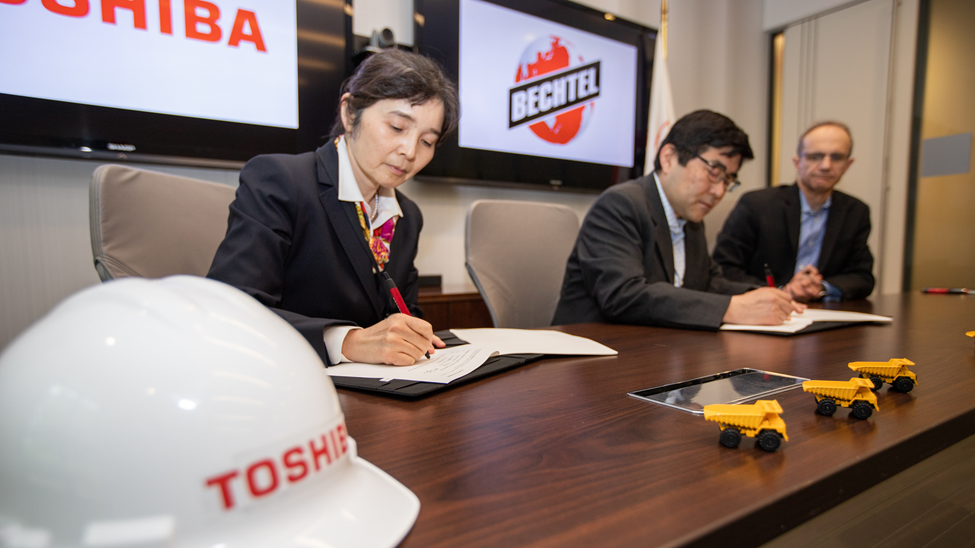Bechtel’s Ahmet Tokpinar (right) at the MOU signing ceremony with Toshiba executives Yuki Arima (left) and Kentaro Takagi. (Photo: Bechtel)
Engineering, construction, and project management firm Bechtel Corporation last week announced the signing of a memorandum of understanding with Toshiba America Energy Systems and Toshiba Energy Systems & Solutions to pursue a civil nuclear power plant project in Poland.
Panelists (from left) Adam Stein, Jon Ball, Mike Laufer, and Michl Binderbauer during the Breaking Through: Assessing the Current State and Prospects of Nuclear Innovation in the Race to Decarbonize session at the ANS Annual Meeting.
If nuclear innovators are in a race to decarbonize, it is a race with one finish line—affordable, clean, and reliable power—and many ways to get there. Over 40 fission developers and 20 fusion developers are in the running, and while attendees of the June 13 ANS Annual Meeting executive session on Breaking Through: Assessing the Current State and Prospects of Nuclear Innovation in the Race to Decarbonize heard from representatives of just three of those companies, they presented very different designs and deployment approaches, aptly reflecting the broader diversity of nuclear power innovation.
Session chair Adam Stein, director of nuclear energy innovation at the Breakthrough Institute, welcomed representatives from an advanced non–light water reactor developer (Mike Laufer, Kairos Power), a small modular light water reactor developer (Jon Ball, GE Hitachi Nuclear Energy), and a fusion power developer (Michl Binderbauer, TAE Technologies). Together they explored the challenge of engineering a significant commercial scale-up of advanced nuclear technology by the end of the decade, tackling questions of cost, schedule, supply chain, regulation, and more.
A cutaway of the Integral Molten Salt Reactor and balance of plant. (Image: Terrestrial Energy)
Ammonia is a carbon-free energy carrier that could be produced using thermal energy from nuclear power plants. Terrestrial Energy announced June 9 that it has signed an agreement with engineering firm KBR to explore the use of its Integral Molten Salt Reactor (IMSR) for both hydrogen and ammonia production.
Myrna Simpson conducts molecular biogeochemistry research at the University of Toronto Scarborough. (Photo: Ken Jones/University of Toronto)
Researchers at three Canadian universities are studying whether bentonite clay—used as an engineered barrier in Canada’s proposed deep geological repository—can support sulfide-producing microbes that can eat away at the canisters containing spent nuclear fuel.
IAEA director general Rafael Mariano Grossi addresses workshop attendees. (Photo: IAEA)
The International Atomic Energy Agency convened a workshop last week to explore how nuclear techniques backed by the IAEA’s Zoonotic Disease Integrated Action (ZODIAC) initiative could be used to avoid outbreaks of monkeypox and Lassa fever. The meeting, held in Vienna, Austria, on the sidelines of the IAEA Board of Governors meeting, was organized to assist countries in using nuclear and related techniques to detect, mitigate, and understand the behavior of the viruses.
“It is important that we are reacting quickly, as things happen. I am happy that concrete work is being carried out on something before it becomes a very difficult problem,” said IAEA director general Rafael Mariano Grossi as he opened the one-day summit.
Concept art for the NUWARD plant. (Image: TechnicAtome)
French utility giant EDF has announced that its NUWARD small modular reactor design will be the case study for a European early joint regulatory review led by the French Nuclear Safety Authority (ASN). Also participating in the review process will be the Czech Republic’s State Office for Nuclear Safety (SUJB) and Finland’s Radiation and Nuclear Safety Authority (STUK).
Artist’s rendering of BWXT’s Project Pele transportable reactor modules arriving for set up and operation. (Image: BWXT)
BWX Technologies, Inc., will deliver the first microreactor in the United States under a contract awarded by the U.S. Department of Defense Strategic Capabilities Office (SCO), the company announced today. BWXT will have two years to build a transportable microreactor prototype to the SCO’s Project Pele specifications and deliver it to Idaho National Laboratory for testing under a cost-type contract valued at about $300 million.
Computer rendering of an IMSR400 plant. (Image: Terrestrial Energy)
The Nuclear Regulatory Commission and Canadian Nuclear Safety Commission have completed a first joint technical review of Terrestrial Energy’s Integral Molten Salt Reactor, the company announced earlier this week.
The IMSR was selected in December 2019 to be the first advanced non–light water nuclear reactor technology to be studied under an August 2019 NRC/CNSC memorandum of cooperation aimed at enhancing regulatory effectiveness through collaborative work on technical reviews of advanced reactor and small modular reactor technologies.
A modified forklift with a customized handling attachment is used to move spent fuel containers and their heavy bentonite clay housings. It can move autonomously or be manually operated remotely from outside the room, as needed. (Photo: NWMO)
Canada’s Nuclear Waste Management Organization (NWMO) has announced that it has successfully completed a full-scale demonstration of the engineered barriers that are designed to contain and isolate Canada’s spent nuclear fuel in a deep geological repository.
SRNS environmental engineers Bryce Garner (left) and Adam Willey (center) ask questions of lead operator Daniel Ferrell (right), from field services contractor Cascade Environmental, as he describes how equipment injects oil and iron into the Savannah River Site’s groundwater. (Photo: DOE)
In this week’s “EM Update,” the Department of Energy’s Office of Environmental Management (EM) reports that its contractor Savannah River Nuclear Solutions (SRNS) has successfully reduced degreasing solvents in the aquifer beneath the Savannah River Site in South Carolina using a technology that injects a form of iron and oil into groundwater.
“The oil attracts the Cold War[–era] cleaning solvents while the iron degrades and neutralizes the contamination,” said Shannan Lucero, SRNS manager for area closure projects.

















